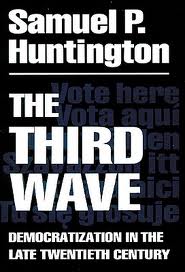Journal of Democracy coeditor Marc F. Plattner wrote the following reply in response to a recent blog post published by political scientist Jay Ulfelder on Dart Throwing Chimp.
Jay Ulfelder’s thoughtful critique of my Journal of Democracy essay “The End of the Transitions Era” makes some interesting points, and there are a number of specific matters about which we agree. Nonetheless, I find his larger critique to be unpersuasive. Our disagreements, all having to do with “waves” of democratization, can be divided into two parts—those about the past and those about the future.
Regarding the past, Ulfelder rightly notes that I emphasize the distinction between the two sets of countries that make up Huntington’s First Wave (1828 – 1926) of democratization: 1) the “dozen or so European and European-settler countries that had already succeeded in establishing a fair degree of freedom and rule of law, and then moved into the democratic column by gradually extending the suffrage”; and 2) “countries that became democratic after World War I, many of them new nations born from the midst of the European empires defeated and destroyed during the war.” I would not object in principle to calling these two separate “waves,” but given the currency still enjoyed by Huntington’s categorizations (especially the Third Wave), it seems to me futile to insist on this.
 Ulfelder himself accepts the “coherence” of Huntington’s Second Wave (1943-62), which occurred in the aftermath of World War II. He argues, however, that Huntington’s Third Wave (1974 -2000) should be divided in two, separating off the southern European and Latin American cases of the 1970s and 1980s from the postcommunist cases that began in 1989 and the African cases that began shortly thereafter. Here I cannot agree with him–and not only because of the wide acceptance of Huntington’s scheme. In the first place, Ulfelder simply omits important transitions in other regions in the mid-to-late 1980s that made the Third Wave clearly global—especially the Philippines, Pakistan, and South Korea. Second, his categorization ignores the fact that several key Latin American countries, including Chile, Nicaragua, and Mexico, did not make their democratic transitions until after 1989. It makes little sense, in my view, to try to designate as two separate “waves” groups of democratic transitions that occurred so close to each other in time and in some cases overlapped. Moreover, as I stated in my original essay, I think one can find some specific ways in which the East European transitions were influenced by the Spanish example, and that even more important was the overall impact that the global democratic resurgence had on decaying regimes in the communist world. The downfall of European communism did not occur in an ideological vacuum.
Ulfelder himself accepts the “coherence” of Huntington’s Second Wave (1943-62), which occurred in the aftermath of World War II. He argues, however, that Huntington’s Third Wave (1974 -2000) should be divided in two, separating off the southern European and Latin American cases of the 1970s and 1980s from the postcommunist cases that began in 1989 and the African cases that began shortly thereafter. Here I cannot agree with him–and not only because of the wide acceptance of Huntington’s scheme. In the first place, Ulfelder simply omits important transitions in other regions in the mid-to-late 1980s that made the Third Wave clearly global—especially the Philippines, Pakistan, and South Korea. Second, his categorization ignores the fact that several key Latin American countries, including Chile, Nicaragua, and Mexico, did not make their democratic transitions until after 1989. It makes little sense, in my view, to try to designate as two separate “waves” groups of democratic transitions that occurred so close to each other in time and in some cases overlapped. Moreover, as I stated in my original essay, I think one can find some specific ways in which the East European transitions were influenced by the Spanish example, and that even more important was the overall impact that the global democratic resurgence had on decaying regimes in the communist world. The downfall of European communism did not occur in an ideological vacuum.
In looking to the future, Ulfelder relies heavily on substituting the notion of a “cluster” of democratic transitions for that of a “wave.” A cluster seems to refer to a set of countries in a particular region that, thanks to their reciprocal influence on one another, democratize in a limited period of time. Based on this concept, Ulfelder points to three regions that offer prospects for future “clusters” of democratic transitions: the Middle East and North Africa, East Asia, and Eurasia (i.e., the former Soviet Union). These are indeed the three regions where most of the world’s nondemocratic regimes are to be found, and I would not rule out the possibility that democratic change could occur in any of them. But I would be very surprised if events in one of these regions were to trigger democratic transitions in the others. I also fear that today democratic backsliding elsewhere is a more likely prospect than democratic advances in any of these three regions.
Ulfelder engages in a bit of sleight-of-hand at the end of his blog post by reintroducing the word “wave” to mean what he had previously redefined as a “cluster.” This enables him to conclude that “contra Plattner, there’s plenty of room left in the system for fresh waves of democratization.” I would agree that plenty of room is left for democratization—that follows simply from the fact that there remain a large number of nondemocratic countries. But in the decade ahead I doubt if we will see even any significant clusters of democratic change, let alone a global wave. And I stand by my claim that the last quarter of the twentieth century witnessed a truly global wave of democratization whose like we will probably never see again.

